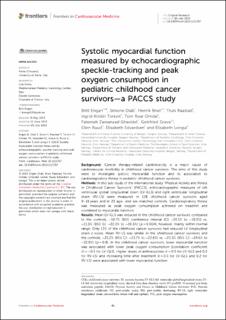| dc.contributor.author | Engan, Britt | |
| dc.contributor.author | Diab, Simone | |
| dc.contributor.author | Brun, Henrik | |
| dc.contributor.author | Raastad, Truls | |
| dc.contributor.author | Torsvik, Ingrid Kristin | |
| dc.contributor.author | Omdal, Tom Roar | |
| dc.contributor.author | Zamanzad Ghavidel, Fatemeh | |
| dc.contributor.author | Greve, Gottfried | |
| dc.contributor.author | Ruud, Ellen | |
| dc.contributor.author | Edvardsen, Elisabeth | |
| dc.contributor.author | Leirgul, Elisabeth | |
| dc.date.accessioned | 2023-12-28T14:36:52Z | |
| dc.date.available | 2023-12-28T14:36:52Z | |
| dc.date.created | 2023-09-13T10:22:51Z | |
| dc.date.issued | 2023 | |
| dc.identifier.issn | 2297-055X | |
| dc.identifier.uri | https://hdl.handle.net/11250/3109053 | |
| dc.description.abstract | Background: Cancer therapy-related cardiotoxicity is a major cause of cardiovascular morbidity in childhood cancer survivors. The aims of this study were to investigate systolic myocardial function and its association to cardiorespiratory fitness in pediatric childhood cancer survivors.
Methods: In this sub-study of the international study “Physical Activity and fitness in Childhood Cancer Survivors” (PACCS), echocardiographic measures of left ventricular global longitudinal strain (LV-GLS) and right ventricular longitudinal strain (RV-LS) were measured in 128 childhood cancer survivors aged 9–18 years and in 23 age- and sex-matched controls. Cardiorespiratory fitness was measured as peak oxygen consumption achieved on treadmill and correlated to myocardial function.
Results: Mean LV-GLS was reduced in the childhood cancer survivors compared to the controls, −19.7% [95% confidence interval (CI) −20.1% to −19.3%] vs. −21.3% (95% CI: −22.2% to −20.3%) (p = 0.004), however, mainly within normal range. Only 13% of the childhood cancer survivors had reduced LV longitudinal strain z-score. Mean RV-LS was similar in the childhood cancer survivors and the controls, −23.2% (95% CI: −23.7% to −22.6%) vs. −23.3% (95% CI: −24.6% to −22.0%) (p = 0.8). In the childhood cancer survivors, lower myocardial function was associated with lower peak oxygen consumption [correlation coefficient (r) = −0.3 for LV-GLS]. Higher doses of anthracyclines (r = 0.5 for LV-GLS and 0.2 for RV-LS) and increasing time after treatment (r = 0.3 for LV-GLS and 0.2 for RV-LS) were associated with lower myocardial function.
Conclusions: Left ventricular function, but not right ventricular function, was reduced in pediatric childhood cancer survivors compared to controls, and a lower left ventricular myocardial function was associated with lower peak oxygen consumption. Furthermore, higher anthracycline doses and increasing time after treatment were associated with lower myocardial function, implying that long-term follow-up is important in this population at risk. | en_US |
| dc.language.iso | eng | en_US |
| dc.publisher | Frontiers | en_US |
| dc.rights | Navngivelse 4.0 Internasjonal | * |
| dc.rights.uri | http://creativecommons.org/licenses/by/4.0/deed.no | * |
| dc.title | Systolic myocardial function measured by echocardiographic speckle-tracking and peak oxygen consumption in pediatric childhood cancer survivors—a PACCS study | en_US |
| dc.type | Journal article | en_US |
| dc.type | Peer reviewed | en_US |
| dc.description.version | publishedVersion | en_US |
| dc.rights.holder | Copyright 2023 The Author(s) | en_US |
| dc.source.articlenumber | 1221787 | en_US |
| cristin.ispublished | true | |
| cristin.fulltext | original | |
| cristin.qualitycode | 1 | |
| dc.identifier.doi | 10.3389/fcvm.2023.1221787 | |
| dc.identifier.cristin | 2174594 | |
| dc.source.journal | Frontiers in Cardiovascular Medicine | en_US |
| dc.identifier.citation | Frontiers in Cardiovascular Medicine. 2023, 10, 1221787. | en_US |
| dc.source.volume | 10 | en_US |

